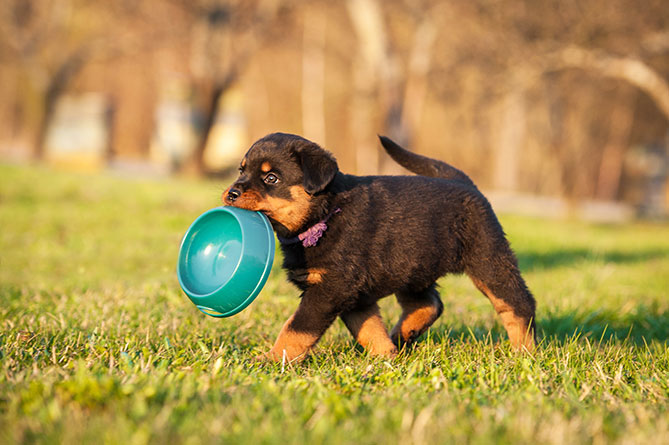Understanding what to feed your new puppy is an important for your puppy’s future health, and a huge responsibility. With the ever-growing range of pet food available to you, your decisions based on foods are bound to be challenging. Ask the question of “what’s best for my pup?” and you’re likely to be met with a range of different answers depending on who you ask.
While opinions may vary on types of foods and brands, one thing that remains the same is that your puppy’s nutritional needs are the greatest they will ever need to be. The puppy stage sets a foundation for your dog’s entire life, so it’s important to give diet the proper attention it requires.
The developing puppy
For most dogs, the puppy stage lasts for around 12 months. For large or giant breeds, the puppy stage will be around 24 months.
When we think of puppies, some may imagine an adorably tiny dog stumbling around the world as they explores with barely opened eyes. Others picture a whirlwind of doggy energy that can’t keep still for a second because there’s too many balls to chase, scents to smell and things to pee on. Whatever the scenario, puppies are undergoing rapid physical development, including:
- The growing of bones and joints to full size
- The growing and development of muscles
- The growing and developing of internal organs
- The development of the immune system
- Cognitive development and brain growth
- Teething
Just as you would a baby, you need to support your puppy through this rapidly developing time. Nutrition is a crucial part of this and your puppy’s diet should include:
Protein: Protein is the building block of muscle, skin, coat, organs and other tissues. It also assists in creating body chemicals like hormones and enzymes that are needed for normal function. Protein provides energy and keeps the immune system strong.
Calcium and phosphorus: These necessary ingredients promote healthy bones and teeth when fed at the right ratio – around 1.2 parts of calcium for each 1 part of phosphorus. Calcium is essential for bone formation, blood coagulation, muscle contraction and nerve impulse transmission. Together with phosphorus, the two work to maintain the growth and structure of the skeletal system.
Omega fatty acids: The two main classes of fatty acids – omega-3s and omega-6s – play important roles in skin and coat health, controlling allergies, inflammation, joint health and the function of some organs.
A puppy requires a lot of food. From birth to six months of age, they’ll need to eat two to four times as much as an adult dog to support all the growth that’s happening. A good rule of thumb (paw in this case) is that after his first week of life, a puppy should gain one to two grams per kilo of anticipated adult weight each day. This means that if your German Shepherd puppy weighs 35 kilos as an adult, they should gain three to five grams per day as a puppy.
Food options
As a pet owner, you can choose to feed your pet commercial pet food, your own homemade diet or a combination of both.
Commercial pet food: The beauty of commercial pet foods are that they take the guess work out for you. Generally speaking, puppy food is higher in protein and enriched with vitamins, minerals, and fats essential for growth when compared with pet food manufactured for older dogs.
Prepared pet foods are a great way to feed your puppy, offering abundant choices of food types, varieties and flavours to enable you to choose the foods that best suit your pet and your lifestyle at a price to suit every budget. Still, ingredients across brands can vary greatly.
The good news is that over 98% of pet foods sold in Australia are members of the Pet Food Industry Association of Australia (PFIAA). The quality and safety of prepared pet foods made and marketed by PFIAA members is world-class, largely due to the selection of raw material and ingredients, manufacturing capabilities and quality systems of member companies.
The best commercial food choices for your puppy are the ones that have been designed to meet their unique nutritional needs and take into account their age, size and breed. Ingredients you want to look for include:
- Whole meat and whole grains (rice, maize, buckwheat and oats)
- Identifiable animal-based protein such as chicken, lamb or beef
- Fats from a clearly labelled source ie. chicken fat or vegetable oil
- Vitamins A,B,C,E & K (no more than 1% of total nutrients)
Ingredients you don’t want are:
- Pesticides, antibiotics or growth hormones
- BHA, BHT, Propylene Glycol or synthetic vitamin K
- Artificial flavours or colours
- Blanket terms such as “animal fat” or “by-product”
- Added sugar
- Beef bone meal or cellulose
Homemade diet: It’s important that the diet you feed your puppy is “complete and balanced,” meaning it meets all of your puppy’s nutritional needs. As long as the food you feed your puppy is varied, this doesn’t mean that EVERY meal must be complete and balanced.
Home-prepared diets that include a wide variety of foods fed at different meals rely on balance over time. Similar to the way humans eat, as long as your puppy gets everything he needs spread out over the week, his diet will be complete and balanced.
Do be aware, however, that puppies are more susceptible to problems caused by nutritional deficiencies or excesses than adult dogs are. Large breed puppies are particularly at risk from too much calcium prior to puberty for example. For this reason, incorporating some dry commercial puppy food can be a smart move.
As a guide, your puppy’s homemade diet should consist of a range of:
- Lean meat and other animal products (choose human-grade meats rather than pet mince or pet rolls)
- Raw meaty bones (especially around 12 weeks old when permanent teeth are erupting)
- Fish and tinned sardines or tuna
- Organs
- Fruits and vegetables
- Eggs
- Whole grains (keep amounts small as can contribute to inflammation or digestive issues)
When and how much to feed your puppy
When you first get your puppy (usually around 8-weeks-old) it is recommended you give him three scheduled feeds a day. Once your puppy reaches six months, switch to two feeds and maintain this through to maturity.
A new pet food should always be introduced gradually, even if your pet is enjoying it! This helps to reduce chance of stomach upsets. Changes to diet affect different animals in different ways, so it’s always important to manage change gradually.
Avoid chilled foods, and if you are using canned food, warm the new food to body temperature, but not hotter! Most animals will prefer canned food slightly warm as it can improve the taste and smell. You can change the texture of canned food by adding a small amount of warm water to soften it. You may want to add some warm water to dry food to soften it too.
Don’t be tempted to add human food titbits to the new diet – it could create a bad habit and poor health in the long run!
The amount you feed your puppy will depend on their size, age, activity, environment and body metabolism. Start with the feeding instructions on the package and observe your pet’s condition over time. If necessary, adjust the amount accordingly. If you are choosing to feed a homemade diet, talk to your vet about how much food is appropriate.
If your pet is fussy, try hand feeding, it is important to make sure your pal is not starved!
Always monitor your puppy’s body condition to prevent them from becoming overweight. Calories from protein, fat and carbohydrates provide energy, but when these are not being used, will generally be deposited as excess weight.







Leave A Comment